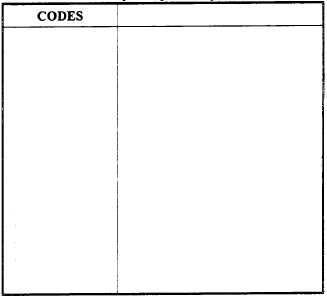plotted and analyzed weather products), and recorder
charts (machine plotted traces of record information).
Form. These are preprinted paper documents
that use blank lines or spaces for the entry of
information.
REVIEW QUESTIONS
Q1.
How are files normally organized?
Q2.
What term is used to describe a written statement
that officially prescribes or establishes policy,
methods, or procedures?
Q3.
By definition, notices are only effective for what
maximum period of time?
ORGANIZATION OF FILES,
DIRECTIVES, AND RECORDS
LEARNING OBJECTIVES: Describe how
files, directives, and records are organized.
Identify the basic format of the Standard
Subject Identification Code (SSIC). Identify
the directive that contains instructions for
assigning SSICs.
Identify the directive that
lists effective instructions for major naval
commands.
In the Navy, both tiles (which may contain official
records) and directives are organized according to the
Standard Subject Identification Code (SSIC) system.
The reference manual used to assign codes for specific
subjects is SECNAVINST 5210.11, Department of the
Navy File Maintenance Procedures and Standard
Subject Identification Codes (SSIC), often referred to as
the SSIC manual. Instructions are provided to help you
assign a code for any subject. The instruction states that
all Navy and Marine Corps letters, messages,
directives, forms, records, and reports should be
assigned an SSIC by the originator. The SSICs are used
as the basis for filing all information received or
originated as letters, messages, directives, etc.
There are thirteen major subject groups in the SSIC
system, each designated by the thousands digit(s) in a
four- or five-number code, as shown in table 3-1.
Each major subject category is broken down into
primary subjects, as identified by the hundreds digit of
the code. The primary subjects are then broken down
into secondary subjects, as identified by the tens digit in
Table 3-1.—Major Subject Groups of the SSIC
CODES
MAJOR SUBJECT GROUP
1000 to 1999
Military Personnel
2000 to 2999
Telecommunications
3000 to 3999
Operations and Readiness
4000 to 4999
Logistics
5000 to 5999
General Administration and
Management
6000 to 6999
Medicine and Dentistry
7000 to 7999
Financial Management
8000 to 8999
Ordnance Material
9000 to 9999
Ships Design and Material
10000 to 10999
General Material
11000 to 11999
Facilities and Activities Ashore
12000 to 12999
Civilian Personnel
13000 to 13999
Aeronautical and Astronautical
Material
the code. The last digit in the code reflects a tertiary
(third) subject. The SSIC manual assigns codes through
the secondary subjects in all cases, and through the
tertiary subjects in many cases. Codes may be assigned
locally by using numbers following a decimal point to
further break down or classify a subject. As an example,
the code used for NAVMETOCCOMINST 3142.1
represents the major subject group 3000, for Operations
and Readiness; the primary subject 100, Operations;
the secondary subject 40, for Geophysical and
Hydrographic or Mapping, Charting, and Geodesy
Support, General; and the tertiary subject 2, for data
collection. NAVMETOCCOM assigned the decimal .l
to identify Pilot Weather Reports (PIREPS). Letters
following the last digit, such as 3142.1A, are used to
indicate periodic revisions of instructions. The letters
are used in sequential order.
You will rarely be required to assign an SSIC to a
subject. All incoming naval message traffic and most
naval correspondence will contain an SSIC. In message
traffic, the SSIC is the five-digit number within double
slants following the message classification. You may
have seen observations before that have contained the
classification line U N C L A S //N03141//. The N
means a U.S. Navy SSIC follows, and the 3141 is the
SSIC. In naval messages, the code is always expressed
as a five-digit number, and only codes down to the
tertiary subject-level are used.
All naval letters and some memoranda will contain
SSICs. Naval letters will contain a four or five-digit
SSIC as the first entry in the identification information
on the top right side of the page following the letterhead.
Figure 3-1 is an example of the standard naval letter
format.
3-2



